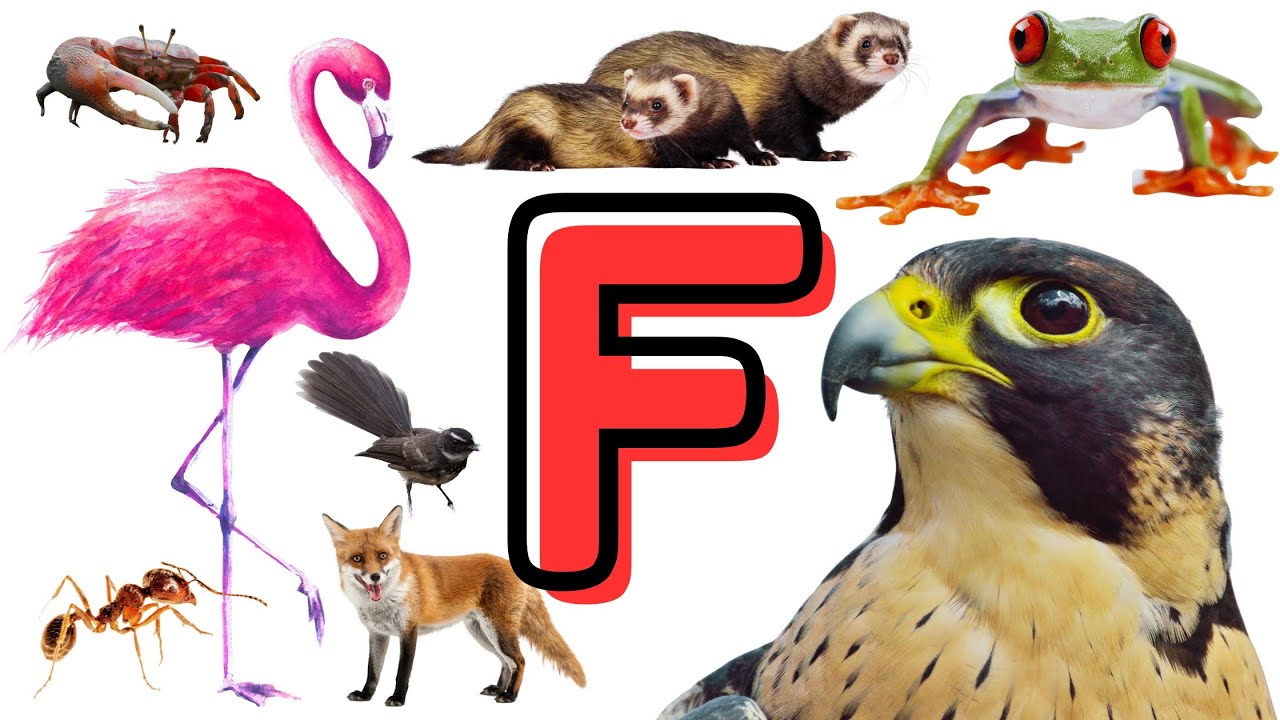Home>Pets & Animals>Fascinating Animals That Start With The Letter ‘F’


Pets & Animals
Fascinating Animals That Start With The Letter ‘F’
Published: January 29, 2024
Discover a variety of fascinating pets and animals that start with the letter 'F.' From fluffy felines to fierce fish, explore the diverse world of fauna beginning with this letter.
(Many of the links in this article redirect to a specific reviewed product. Your purchase of these products through affiliate links helps to generate commission for Noodls.com, at no extra cost. Learn more)
Table of Contents
Frogs
Frogs are fascinating creatures that captivate the imagination with their unique features and behaviors. These amphibians are found in diverse habitats across the globe, from tropical rainforests to arid deserts. Known for their distinctive croaking calls and remarkable life cycle, frogs play a vital role in maintaining ecological balance.
Diversity and Adaptations
Frogs exhibit a remarkable diversity in size, color, and behavior. From the tiny Brazilian Gold Frog, which measures only 9.8 mm in length, to the Goliath Frog, which can grow up to 32 cm, these amphibians showcase a wide range of sizes. Their colors vary from vibrant hues of green, red, and blue to earthy tones that aid in camouflage.
One of the most intriguing adaptations of frogs is their ability to breathe through their skin. This unique feature allows them to absorb oxygen directly from the environment, making them highly adaptable to various ecosystems. Additionally, their powerful hind legs enable them to leap great distances, aiding in both hunting and evading predators.
Life Cycle and Reproduction
The life cycle of a frog is a remarkable journey that begins in water. Female frogs lay eggs in water, which hatch into tadpoles. These aquatic larvae undergo a fascinating transformation, developing limbs and losing their tails as they metamorphose into adult frogs. This process, known as metamorphosis, is a testament to the resilience and adaptability of these amphibians.
Ecological Importance
Frogs play a crucial role in maintaining the balance of ecosystems. As both predators and prey, they contribute to controlling insect populations while serving as a food source for various predators. Their permeable skin also makes them sensitive to environmental changes, making them valuable indicators of ecosystem health.
Conservation Efforts
Despite their ecological significance, many frog species are facing threats due to habitat loss, pollution, and disease. Conservation efforts aimed at protecting frog populations are crucial for preserving biodiversity. Initiatives such as habitat restoration, captive breeding programs, and public awareness campaigns are essential in safeguarding these unique amphibians for future generations.
From their diverse adaptations to their vital ecological role, frogs continue to inspire awe and fascination. Their presence in various cultures and ecosystems underscores their significance, making them a subject of admiration and conservation efforts worldwide.
Flamingos
Flamingos are iconic birds known for their stunning pink plumage and distinctive long, slender necks. These graceful creatures are often associated with tropical and subtropical regions, where they inhabit shallow lakes, lagoons, and coastal mudflats. Their striking appearance and unique behaviors make them a captivating subject of fascination for wildlife enthusiasts and casual observers alike.
Striking Physical Features
One of the most striking features of flamingos is their vibrant pink feathers, which result from their diet rich in carotenoid pigments found in algae and crustaceans. This natural diet contributes to the birds' stunning coloration, with hues ranging from soft pink to deep coral. In addition to their captivating plumage, flamingos are recognized for their long, slender necks, which enable them to forage for food in shallow waters with remarkable agility.
Sociable Behavior and Group Dynamics
Flamingos are highly social birds, often forming large flocks that can number in the thousands. These communal gatherings serve various purposes, including mating displays, foraging for food, and providing protection from predators. The synchronized movements of flamingo flocks, whether in flight or wading through the water, create a mesmerizing spectacle that showcases their coordinated behavior and collective strength.
Unique Feeding Habits
The feeding behavior of flamingos is a spectacle to behold. Using their specialized bills, they filter water and mud to extract small crustaceans, algae, and invertebrates. Their uniquely shaped bills, which feature a characteristic downward bend, are perfectly adapted to their filter-feeding technique. This specialized feeding behavior not only sustains the flamingos but also contributes to the health of the ecosystems they inhabit.
Breeding Rituals and Nesting Sites
During the breeding season, flamingos engage in elaborate courtship displays, which involve synchronized movements, vocalizations, and the formation of large breeding colonies. These colonies, often located on remote islands or in protected wetland areas, provide the necessary seclusion and safety for nesting. The construction of mud mounds for nesting and the careful incubation of eggs by both parents highlight the dedication and resilience of these remarkable birds.
Conservation Status and Challenges
While flamingos are celebrated for their beauty and grace, they face various threats, including habitat loss, pollution, and disturbance of nesting sites. Conservation efforts focused on protecting their habitats, regulating human activities in their breeding areas, and raising awareness about the importance of preserving these charismatic birds are crucial for their long-term survival.
From their captivating appearance to their intricate social dynamics, flamingos continue to captivate the imagination of people around the world. Their presence in diverse ecosystems serves as a reminder of the intricate balance of nature and the importance of safeguarding the habitats that sustain these remarkable birds.
Foxes
Foxes are fascinating and adaptable members of the Canidae family, known for their intelligence, agility, and remarkable survival skills. These carnivorous mammals are found in a wide range of habitats, from forests and grasslands to urban areas, where they have thrived alongside human populations. Their distinctive features and intriguing behaviors make them a subject of admiration and curiosity for wildlife enthusiasts and researchers alike.
Diverse Species and Characteristics
Foxes are a diverse group, with species distributed across different continents, including the red fox, Arctic fox, gray fox, and fennec fox. Each species exhibits unique physical and behavioral traits that enable them to thrive in their respective environments. The red fox, known for its reddish-orange fur and bushy tail, is the largest and most widely distributed fox species, found in diverse habitats across Europe, Asia, and North America. In contrast, the Arctic fox, with its thick, white fur and compact body, is specially adapted to survive in the harsh Arctic tundra, showcasing remarkable resilience in extreme cold conditions.
Adaptations and Survival Strategies
Foxes are renowned for their resourcefulness and adaptability, traits that have enabled them to thrive in various ecosystems. Their keen sense of hearing, sharp eyesight, and acute sense of smell make them efficient hunters, capable of detecting prey and navigating their surroundings with precision. Additionally, foxes are skilled at utilizing diverse food sources, including small mammals, birds, insects, fruits, and carrion, showcasing their ability to adapt their diet to seasonal and environmental changes.
Social Structure and Communication
While foxes are often portrayed as solitary animals, they exhibit complex social behaviors and communication methods. Red foxes, for example, form family groups consisting of a breeding pair and their offspring, engaging in cooperative hunting and raising their young in underground dens. Their communication involves a wide range of vocalizations, from barks and screams to high-pitched whines, enabling them to convey information about territory boundaries, mating readiness, and potential threats.
Urban Adaptation and Human Interactions
In recent years, foxes have demonstrated remarkable adaptability to urban environments, where they coexist with human populations. Their ability to thrive in urban areas is a testament to their resilience and capacity to exploit new resources. While their presence in urban settings can sometimes lead to conflicts with humans, efforts to understand and coexist with these intelligent creatures have led to innovative solutions for managing human-fox interactions in urban landscapes.
Conservation and Management
As human activities continue to impact natural habitats, the conservation of fox species becomes increasingly important. Efforts to protect fox populations involve habitat conservation, management of human-wildlife conflicts, and research to understand the ecological roles of foxes in their respective ecosystems. By promoting coexistence and raising awareness about the value of foxes in maintaining ecological balance, conservation initiatives aim to ensure the long-term survival of these remarkable and adaptable carnivores.
From their diverse species to their remarkable adaptations, foxes continue to intrigue and inspire admiration. Their presence in various ecosystems serves as a reminder of the resilience and adaptability of wildlife in the face of environmental changes, making them a captivating subject of study and conservation efforts worldwide.
Falcons
Falcons are a group of raptors known for their exceptional speed, agility, and predatory prowess. These birds of prey are revered for their aerial acrobatics and remarkable hunting abilities, making them a subject of fascination for bird enthusiasts and falconry practitioners worldwide.
Diverse Species and Adaptations
The falcon family encompasses a diverse range of species, each with unique characteristics and adaptations tailored to their hunting strategies and habitats. From the peregrine falcon, renowned as the fastest animal on the planet, to the kestrel, known for its hovering hunting technique, falcons showcase a remarkable array of adaptations that enable them to thrive in various environments. Their sharp, hooked beaks and powerful talons, coupled with exceptional eyesight and maneuverability, equip them for efficient pursuit and capture of prey in mid-air.
Aerial Predators and Hunting Techniques
Falcons are renowned for their aerial hunting prowess, employing high-speed stoops and precise aerial maneuvers to capture prey. The peregrine falcon, in particular, is celebrated for its breathtaking hunting dives, reaching speeds of over 240 miles per hour as it descends upon its unsuspecting prey. This remarkable speed and agility enable falcons to swiftly intercept and seize their quarry mid-flight, showcasing a level of precision and skill that sets them apart as apex aerial predators.
Cultural Significance and Conservation
Throughout history, falcons have held cultural significance in various societies, often revered as symbols of power, speed, and grace. The art of falconry, a practice dating back thousands of years, involves training falcons for hunting alongside humans, highlighting the deep connection between these birds and human civilization. In the modern era, conservation efforts aimed at protecting falcon populations and their habitats are crucial for safeguarding these iconic raptors. Initiatives focused on habitat preservation, captive breeding programs, and research into the ecological roles of falcons contribute to ensuring the long-term survival of these magnificent birds.
Urban Adaptation and Conservation Challenges
In recent years, some falcon species have demonstrated remarkable adaptability to urban environments, nesting on skyscrapers and utilizing urban landscapes for hunting and roosting. While this urban presence provides opportunities for public engagement and awareness, it also presents challenges related to human-wildlife conflicts and exposure to environmental hazards. Conservation efforts in urban settings aim to address these challenges while promoting coexistence and appreciation for these awe-inspiring birds.
The Majesty of Falcons
From their exceptional speed and aerial prowess to their cultural significance and conservation importance, falcons continue to captivate the imagination of people around the world. Their presence in diverse ecosystems serves as a reminder of the intricate balance of nature and the importance of safeguarding the habitats that sustain these remarkable birds.
Fennec Foxes
Fennec foxes, scientifically known as Vulpes zerda, are captivating creatures renowned for their distinctive physical attributes and remarkable adaptations to desert environments. These small foxes, native to the arid regions of North Africa, particularly the Sahara Desert, have captured the fascination of wildlife enthusiasts and researchers alike.
Unique Physical Features and Adaptations
Fennec foxes are instantly recognizable by their striking features, including oversized ears that serve multiple purposes. These large ears, measuring up to 6 inches in length, play a crucial role in dissipating body heat, allowing the foxes to regulate their temperature in the extreme heat of the desert. Additionally, their keen sense of hearing enables them to detect prey and potential predators in their expansive desert habitat. The sandy fur of fennec foxes serves as effective camouflage, blending seamlessly with the desert landscape and providing protection from both predators and the harsh elements.
Read more: Unveiling 5-letter Words Starting With “Ca”.
Desert Survival Strategies
In their harsh desert environment, fennec foxes have evolved impressive adaptations to thrive in arid conditions. Their specialized kidneys enable them to efficiently conserve water, allowing them to survive on the moisture obtained from their diet, which includes insects, small rodents, and desert vegetation. Furthermore, their remarkable digging abilities enable them to create elaborate underground burrows, providing shelter from the scorching desert sun and offering a safe haven for raising their young.
Social Behavior and Communication
Fennec foxes exhibit complex social behaviors, often forming small family groups consisting of a mating pair and their offspring. Their communication involves a range of vocalizations, including soft barks and chirps, which facilitate interactions within the group and serve as a means of signaling territory boundaries and mating readiness. These social dynamics contribute to the survival and well-being of the fennec fox population in their challenging desert habitat.
Conservation Status and Challenges
While fennec foxes are revered for their adaptability and resilience, they face conservation challenges due to habitat loss, human encroachment, and the exotic pet trade. Efforts to protect their desert habitats, mitigate human-wildlife conflicts, and combat illegal trade are essential for ensuring the long-term survival of these captivating desert dwellers.
The Enigmatic Fennec Foxes
From their remarkable adaptations to their captivating presence in the desert ecosystem, fennec foxes continue to inspire admiration and intrigue. Their ability to thrive in one of the world's harshest environments serves as a testament to the resilience and ingenuity of wildlife, making them a subject of fascination and conservation efforts in the realm of desert biodiversity.
Fireflies
Fireflies, also known as lightning bugs, are enchanting insects that illuminate the night with their mesmerizing bioluminescent displays. These remarkable beetles belong to the Lampyridae family and are renowned for their ability to produce light through a chemical reaction, creating a magical spectacle that has captivated the imagination of people of all ages.
Bioluminescent Marvel
The bioluminescent phenomenon displayed by fireflies is a result of a complex chemical process within their bodies. The enzyme luciferase interacts with a light-emitting compound called luciferin, along with oxygen, calcium, and adenosine triphosphate (ATP), to produce a cold light with minimal heat emission. This unique form of light production, known as bioluminescence, allows fireflies to create a soft, greenish glow that is visible in the darkness of the night.
Mating Rituals and Communication
The mesmerizing light displays of fireflies serve a crucial purpose in their mating rituals and communication. Each firefly species has its distinct pattern of light flashes, which are used to attract potential mates. The synchronized blinking of males and the responsive signals from females create a captivating dance of light in the evening air. This intricate communication through bioluminescent signals plays a vital role in ensuring successful mating and reproduction within firefly populations.
Habitat and Ecological Significance
Fireflies are commonly found in diverse habitats, including grasslands, forests, and wetlands, where they contribute to the ecological balance through their role as both predators and prey. As larvae, fireflies play a beneficial role in controlling populations of snails, slugs, and other pests, contributing to natural pest management in their respective ecosystems. Additionally, their presence as a food source for various predators highlights their significance in the intricate web of nocturnal biodiversity.
Conservation Concerns and Preservation Efforts
Despite their enchanting presence, fireflies face conservation challenges due to habitat loss, light pollution, and the use of pesticides. The disruption of their natural habitats and the interference of artificial light sources can impact their ability to communicate and reproduce. Conservation efforts focused on preserving their habitats, reducing light pollution, and raising awareness about the importance of safeguarding firefly populations are essential for their continued existence.
The Enchantment of Fireflies
The ethereal glow of fireflies illuminating the night sky continues to evoke a sense of wonder and enchantment. Their bioluminescent displays not only captivate our senses but also serve as a reminder of the delicate balance of nature and the importance of preserving the habitats that sustain these magical insects. As we strive to protect the habitats of fireflies, we ensure that future generations can experience the mesmerizing beauty of these captivating creatures.
Frigatebirds
Frigatebirds, belonging to the Fregatidae family, are magnificent seabirds renowned for their impressive aerial prowess and striking physical features. These iconic birds, found in tropical and subtropical regions across the globe, have captivated the fascination of bird enthusiasts and researchers due to their remarkable adaptations and unique behaviors.
Aerial Mastery and Adaptations
Frigatebirds are renowned for their exceptional flying abilities, characterized by effortless soaring and maneuvering across expansive oceanic territories. Their long, angular wings and deeply forked tails enable them to navigate the open skies with remarkable agility, utilizing air currents to cover vast distances in search of food. Their mastery of aerial navigation and their ability to remain airborne for extended periods showcase their remarkable adaptations to a life intertwined with the open ocean.
Feeding Behaviors and Foraging Techniques
These seabirds are adept at foraging for food, often relying on their remarkable agility and predatory skills to capture prey. Frigatebirds are known for their unique feeding technique, where they skillfully snatch food from the surface of the water or engage in aerial piracy by harassing other seabirds to relinquish their catch. Their impressive aerial maneuvers and precise targeting abilities enable them to secure sustenance while in flight, showcasing their proficiency as apex predators of the open seas.
Breeding and Courtship Rituals
During the breeding season, frigatebirds engage in elaborate courtship displays, with males showcasing their inflatable red throat pouches to attract potential mates. These captivating displays, accompanied by vocalizations and intricate aerial dances, serve as a testament to the complex social dynamics and mating rituals of these seabirds. The selection of suitable nesting sites, often in remote coastal areas or on isolated islands, highlights their dedication to ensuring the survival of their offspring in challenging marine environments.
Conservation Challenges and Protection Efforts
While frigatebirds are celebrated for their remarkable adaptations and aerial prowess, they face conservation challenges due to habitat degradation, marine pollution, and human disturbances in their nesting areas. Conservation efforts focused on protecting their breeding sites, regulating fishing practices to minimize bycatch, and raising awareness about the importance of preserving marine ecosystems are crucial for the long-term survival of these captivating seabirds. By addressing these challenges and promoting sustainable coexistence with frigatebirds, we can ensure the preservation of their vital ecological roles in marine environments.
The Majesty of Frigatebirds
From their awe-inspiring aerial displays to their crucial role in marine ecosystems, frigatebirds continue to inspire admiration and respect. Their presence in the open oceans serves as a reminder of the interconnectedness of life across diverse habitats, highlighting the importance of safeguarding the marine environments that sustain these magnificent seabirds. As we strive to protect the habitats and nesting sites of frigatebirds, we contribute to the conservation of marine biodiversity and the preservation of these iconic avian marvels for generations to come.






